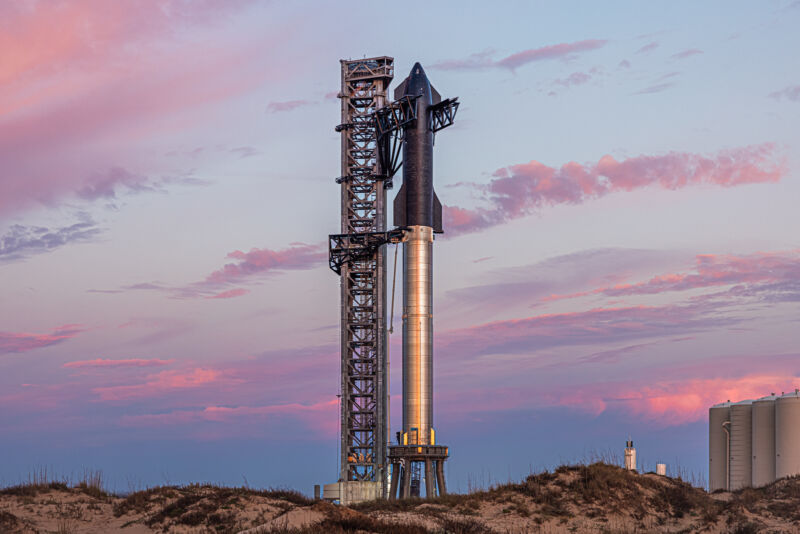It has been a long time since SpaceX launched a rocket from South Texas. After a flurry of seven Starship prototype test flights from August 2020 through May 2021, the company has not flown from its launch pads near Boca Chica Beach.
There are good reasons for this hiatus and good reasons to believe it may soon change as SpaceX makes progress toward an orbital launch attempt from South Texas later this year.
The seven launches of a full-scale Starship prototype gradually pushed the envelope, beginning with two 150-meter hops before moving to flights as high as 12.5 km to demonstrate a belly-flop maneuver that will be needed during the vehicle's return through Earth's atmosphere. The flight test program culminated with a successful soft-landing of Starship after a 10 km flight.
By that point, SpaceX had pushed its Starship prototype about as far as it could go. The vehicle did not have the capability to reach orbit on its own, so SpaceX had to complete development of the "Super Heavy" first stage of the launch system. Because this would be the largest, and most powerful rocket ever built, it would require work to be completed on a number of fronts—from rockets to ground systems to paperwork. And so the launch pads at Boca Chica have been quiet for more than a year.
Finishing Super Heavy itself was a monumental task. As that vehicle required 33 Raptor rocket engines, the company had work to do in terms of production to spool up that kind of capability. By way of comparison, the one-time propulsion leader in the United States, Aerojet Rocketdyne, has set a goal of building four RS-25 rocket engines for NASA's Space Launch System a year. SpaceX is now building at least four Raptor rocket engines a week. The two engines are comparable in terms of their overall power.
Then it became clear to SpaceX founder Elon Musk and his team that the original Raptor rocket engine was too heavy and lacked enough performance. So the company decided to hold off flight tests of Super Heavy until the "Raptor 2" engine was ready. It seems to have been a smart decision. The original Raptor engine produced 185 tons of thrust, but Raptor 2 will have at least 230 tons. It should also cost half as much to build and be considerably more robust once its design matures.
Much effort has also gone into designing and building a massive "launch and catch" tower at the South Texas site. Standing more than 150 meters tall, it supports the fully stacked rocket during fueling and launch operations. Then, minutes after launch, it will catch the first-stage booster with massive "chopsticks" as the rocket slows down near the ground. The entire process of design and construction took about 13 months. SpaceX also had to significantly upgrade its ground support equipment at the Texas site to fuel the Super Heavy and Starship vehicles at the same time.
Finally, there was the paperwork. SpaceX's original environmental approval for the Texas site allowed for about a dozen launches a year of its smaller Falcon 9 and Falcon Heavy rockets. Because the Starship launch system lay outside this scope, the company had to go back to the Federal Aviation Administration and seek permission for much more impactful launches. This kicked off a years-long process. And while it is not yet complete, SpaceX gained an important decision earlier this month when it received a critical regulatory approval. The company now has a path forward to conduct Starship test flights from Texas.
More evidence of progress came on Thursday when SpaceX rolled its "Booster 7" prototype of the Super Heavy rocket to the launch site. It was lifted, for the first time, by "chopsticks" on the launch tower and placed on its launch mount. Seeing a rocket lifted with 33 Raptor 2 engines was, indeed, a sight to see.
If this booster survives pressure testing and potentially a static fire test in the coming days and weeks—by no means a guarantee given the developmental nature of the Raptor 2 engine—it could be the rocket that lofts Starship on an orbital test flight.
Musk, who has been pushing SpaceX forward as rapidly as possible despite his simultaneous efforts to buy Twitter and unrest caused by his actions, recently said he believed an orbital launch attempt could come in July. Another Starship stack, he added, would be ready to fly in August.
As ever, this seems like an over-optimistic projection. But by all accounts, the hardware in South Texas is nearing readiness, and the paperwork is getting done. A launch attempt this year now seems more likely than not.



3175x175(CURRENT).thumb.jpg.b05acc060982b36f5891ba728e6d953c.jpg)


Recommended Comments
There are no comments to display.
Join the conversation
You can post now and register later. If you have an account, sign in now to post with your account.
Note: Your post will require moderator approval before it will be visible.